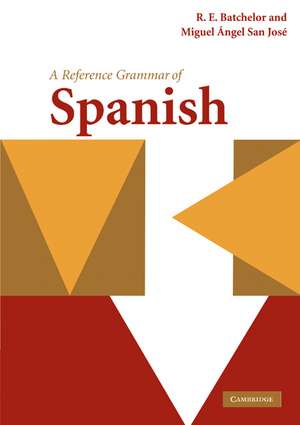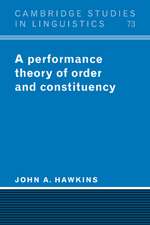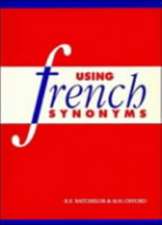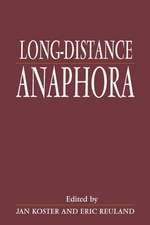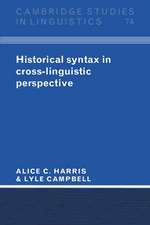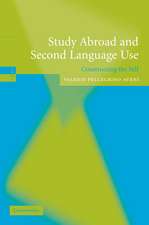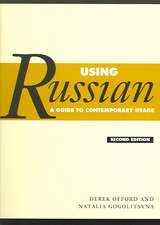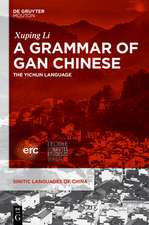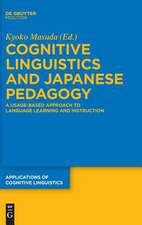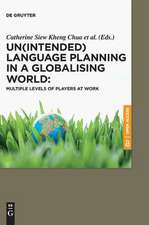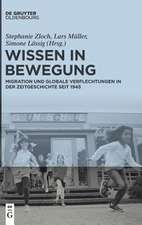A Reference Grammar of Spanish: Reference Grammars
Autor R. E. Batchelor, Miguel Ángel San Joséen Limba Engleză Paperback – 28 apr 2010
| Toate formatele și edițiile | Preț | Express |
|---|---|---|
| Paperback (1) | 496.63 lei 6-8 săpt. | |
| Cambridge University Press – 28 apr 2010 | 496.63 lei 6-8 săpt. | |
| Hardback (1) | 720.24 lei 6-8 săpt. | |
| Cambridge University Press – 28 apr 2010 | 720.24 lei 6-8 săpt. |
Preț: 496.63 lei
Preț vechi: 613.12 lei
-19% Nou
Puncte Express: 745
Preț estimativ în valută:
95.03€ • 99.48$ • 78.63£
95.03€ • 99.48$ • 78.63£
Carte tipărită la comandă
Livrare economică 05-19 aprilie
Preluare comenzi: 021 569.72.76
Specificații
ISBN-13: 9780521728751
ISBN-10: 0521728754
Pagini: 574
Dimensiuni: 174 x 247 x 26 mm
Greutate: 1.11 kg
Editura: Cambridge University Press
Colecția Cambridge University Press
Seria Reference Grammars
Locul publicării:Cambridge, United Kingdom
ISBN-10: 0521728754
Pagini: 574
Dimensiuni: 174 x 247 x 26 mm
Greutate: 1.11 kg
Editura: Cambridge University Press
Colecția Cambridge University Press
Seria Reference Grammars
Locul publicării:Cambridge, United Kingdom
Cuprins
1. Table of contents/Índice de materias; 2. Preface/Prólogo; 3. Introduction to the Spanish language/Introducción a la lengua Española; 4. Acknowledgements/Agradecimientos; 5. Glossary/Glosario; 6. Bibliography/Bibliografía; 7. Abbreviations/Abreviaturas; 8. Register/Registro; 9. Alphabet, spelling, pronunciation/Alfabeto, ortografía, pronunciación; 10. Stress and accent marks/Acento tónico y acento ortográfico; 11. Punctuation/Puntuación, upper case, lower case/mayúsculas, minúsculas; 12. Apocopation/Apócope; 13. Agreement/Concordancia; 14. Definite article/Artículo definido; 15. Indefinite article/Artículo indefinido; 16. Gender/Género; 17. Number (singular and plural)/Número (singular y plural); 18. Verbs: moods of verbs/Verbos: modos de verbos; 19. The infinitive/El infinitivo; 20. Compound perfect infinitive/Infinitivo pretérito perfecto; 21. Infinitive viewed as a noun/Infinitivo como sustantivo; 22. Present tense/Tiempo presente; 23. Perfect tense/Pretérito perfecto; 24. Irregular past participles/Participios de pasado irregulares; 25. Verbs with 2 past participles/Verbos con 2 participios de pasado; 26. Past participles as nouns/Participios de pasado con función de sustantivos; 27. Ablative absolute/Ablativo absoluto; 28. Verbs + infinitive when that is used in English/Verbos + infinitivo cuando se usa that en inglés; 29. Pluperfect tense/Pretérito pluscuamperfecto de indicativo (antecopretérito - A/M); 30. Imperfect tense/Pretérito imperfecto de indicativo (copretérito - A/M); 31. Preterit/Pretérito; 32. Contrasts with the imperfect, preterit and perfect tenses/Contrastes con el pretérito, imperfecto, el pretérito y el pretérito perfecto; 33. Future tense/Futuro; 34. Future perfect tense/Futuro perfecto; 35. Conditional tense/Condicional simple; 36. Conditional perfect tense/Condicional perfecto (antepospretérito - M); 37. Progressive tense or gerund/Progresivo o gerundio; 38. Imperative/Imperativo; 39. Irregular verbs/Verbos irregulares; 40. Radical changing verbs/Verbos con cambio vocálico (diptongación, y verbos del tipo pedir) (i.e. e>i); 41. Verbs with orthographical changes/Verbos con cambios ortográficos; 42. Uses and contrasts of ser and estar/Usos y contrastes de ser y estar; 43. Uses of quedar, resultar etc. as substitutes for ser and estar (including hay)/Usos de quedar, resultar etc. como sustitutos de ser y estar (incluyendo hay); 44. Transitive and intransitive verbs/Verbos transitivos e intransitivos; 45. Reflexive verbs/Verbos reflexivos; 46. Passive voice/Voz pasiva; 47. Defective verbs/Verbos defectivos; 48. Modal auxiliary verbs/Verbos auxiliares modales; 49. Ellipsis of verbs in main and subordinate clauses/Elipsis de verbos en oraciones principales y subordinadas; 50. Uses of dar, haber, ir, llevar, seguir, tener, venir/Usos de dar etc.; 51. Impersonal verbs/Verbos impersonales; 52. Verbs of perception + infinitive or gerund/Verbos de percepción + infinitivo o gerundio; 53. Periphrastic verb forms/Verbos con formas perifrásticas; 54. Subordinate clauses related to time/Oraciones subordinadas referentes al tiempo (duración); 55. Subordinate clauses related to concession/Oraciones subordinadas concesivas; 56. Subordinate clauses related to condition/Oraciones subordinadas condicionales; 57. Subordinate clauses related to consequence/Oraciones subordinadas consecutivas; 58. Subordinate clauses related to manner/Oraciones subordinadas de modol; 59. Verbs concerning unrealized actions/Verbos referentes a acciones no realizadas o inacabadas; 60. Complex verbal expressions/Expresiones complejas de tipo verbal; 61. Verbs of movement in English and Spanish/Verbos indicando movimiento en inglés y español; 62. Subjunctive mood/Modo subjuntivo; 63. Personal pronouns/Pronombres personales; 64. Possessive adjectives and pronouns, also usage with parts of the body and clothes/Adjetivos y pronombres poses
Recenzii
'A Reference Grammar of Spanish joins the ranks as a well-developed and well-written scholarly reference for researchers, faculty and Spanish language students around the world. It gives the spoken and written varieties among the world's Spanish speakers. A grammar book should not be prescriptive or impose one language variety on another. The role of a comprehensive grammar should be to assess and to analyze what is spoken among constituents, not to gauge against a stand-alone variety. Batchelor and San José accomplish their goal well.' The Modern Language Journal
Notă biografică
Descriere
A comprehensive handbook on the structure of the Spanish language; ideal for students and teachers.
